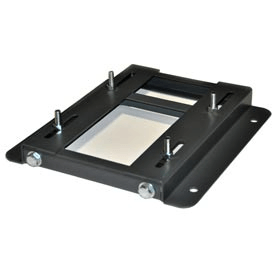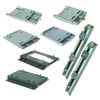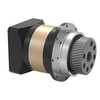Motor Bases Information
 Motor bases function as mounts for electric motors. The devices are fitted with adjustable bolt patterns suitable for different-sized motors that allow necessary position modifications to the motor. Most bases fit NEMA motor sizes.
Motor bases function as mounts for electric motors. The devices are fitted with adjustable bolt patterns suitable for different-sized motors that allow necessary position modifications to the motor. Most bases fit NEMA motor sizes.
The base regulates the pressure in a belt-driven system. This is critical for avoiding belt slippage and excessive strain that lead to higher maintenance costs and additional downtime. Optimal belt tension helps lengthen the service lifetime of components, such as belts and motor bearings.
Types of Motor Bases
Today's market features multiple types of motor bases with two primary categories, including:
Fixed-position adjustable bases: These adjust via manual alteration of the center distance that separates a driver and driven pulleys. They allow pushing or pulling a motor into place to install or adjust the belt. Once the belt is pulled over the pulley, single or multiple screws force the motor away from the driven pulley until the desired tension level is attained. The mounting bolts are then tightened to complete the process.
Base design ranges from simple, one-piece, formed plates to more complex models featuring Z-bars with continuous welding to improve strength. Select versions correspond to NEMA mounting dimensions. Fixed-position bases are preferred due to low initial costs.
The equipment is further broken down into the following classifications:
Single-screw adjustable base possesses a central screw for tension positioning. As the screw turns, the motor moves with the pulley center towards or away from the center of the driven pulley. The operational simplicity offered by this device provides a reasonably-priced option for several applications.
Dual-screw positioning base has two adjustable screws placed beneath the motor feet. Its configuration matches single-screw systems but with reinforced construction for extending the application range. In comparison with the single-screw style, this type of setup supports greater flexibility in shaft alignment and dual screws provide a robust method of maintaining alignment.
Specialized fixed-position bases feature mounting studs extending from slots. While performing tension adjustments the nuts are loosened and the motor is lifted above the studs. If the nuts are loosened more than was necessary, the motor will turn and shift closer to the driven pulley during the tightening process. As a result the tension will exceed the required level and the mounting studs will experience excessive strain when tightening the nuts.
Tension-controlling bases: The structures integrate internal or external tools that automatically alter the center distance of a pulley of a running motor in response to load condition requirements.
Types of tension-controlling devices comprise:
Pivot bases rely on a motor's weight along with its direction of rotation for applying and controlling tension. The motor is mounted on pivoting arms and is held in place with bolt holes and slots configured to fit the frame. The strain in the belt increases with the distance of the motor from the pivoting shaft. Once started, the motor's reaction torque extends the pulley's center distance and builds tension by directing the pivoted arm downward. The arms move upward to decrease the center distance as the operating load increases.
Spring-loading bases employ built-in springs to control belt strain. This unit features a motor positioned on cross members connected to tubes. The formed carriage shifts towards or away from a driven member in response to fluctuating load. The motor is bolted to the free-moving carriage. When the adjustment screw is turned clockwise, the follower nut, spring, and carriage move in the direction opposite to the driven pulley. After installing the belt, further rotation of the screw pushes the carriage to a point where the belt is snug.
Conversion motor bases match newer, smaller motors after they have undergone rerating to accommodate older mounts.
Heavy duty and custom-built bases serve specific purposes and applications. Heavy-duty versions comprise reinforced construction and heavier materials to handle additional stress. Special gussets along with cross braces are sometimes used in these units.
Selection
Fixed-position mechanisms are selected due to their cost advantage over higher priced tension-controlling equipment. They are available in styles that are standard to NEMA mounting dimensions and provide adequate belt tension control. However, such configurations have certain drawbacks, including:
-
Without a movable plate for mounting, system alignment is performed when it is not operating. This entails a certain amount of guesswork and is less optimal than making changes in dynamic mode.
-
When the motor is secured in position and the belt aligned, pulley center distance is locked in. If belt tension is not adequate to drive a maximum load with no slippage, stress can lead to extra wear of components.
-
Such structures face difficulty in dealing with load fluctuations and shock or vibrations.
Tension-controlling bases are more efficient to install and operate. They cope better with situations involving variation in weight. These units hold the advantage in scenarios where many alterations are needed due to location and environment, or where unique mounting requirements exist. They reduce the time to perform changes and can mount motors vertically or horizontally.
Standards
Various standards and specifications apply to motors and their uses in combination with motor bases, including:
NEMA MG 2 -- Construction, selection, installation and use of electric motors
NFPA 70 -- National Electrical Code
Image credit:
- electric motor mounts
- pump motor mounts
- pivoting motor base
- universal motor mounts
- 302 motor mounts
- 56c motor mounts
- adjustable electric motor mounts
- anti vibration electric motor mounts
- d16 motor mounts
- float tube motor mounts
- HVAC blower motor mounts
- IEC pump motor mounts
- NEMA 34 motor mounts
- NEMA c face motor mounts
- resilient ring motor mounts
- rubber electric motor mounts
- shovelhead rubber motor mounts
- tubular motor mounts
- universal electric motor mounts



